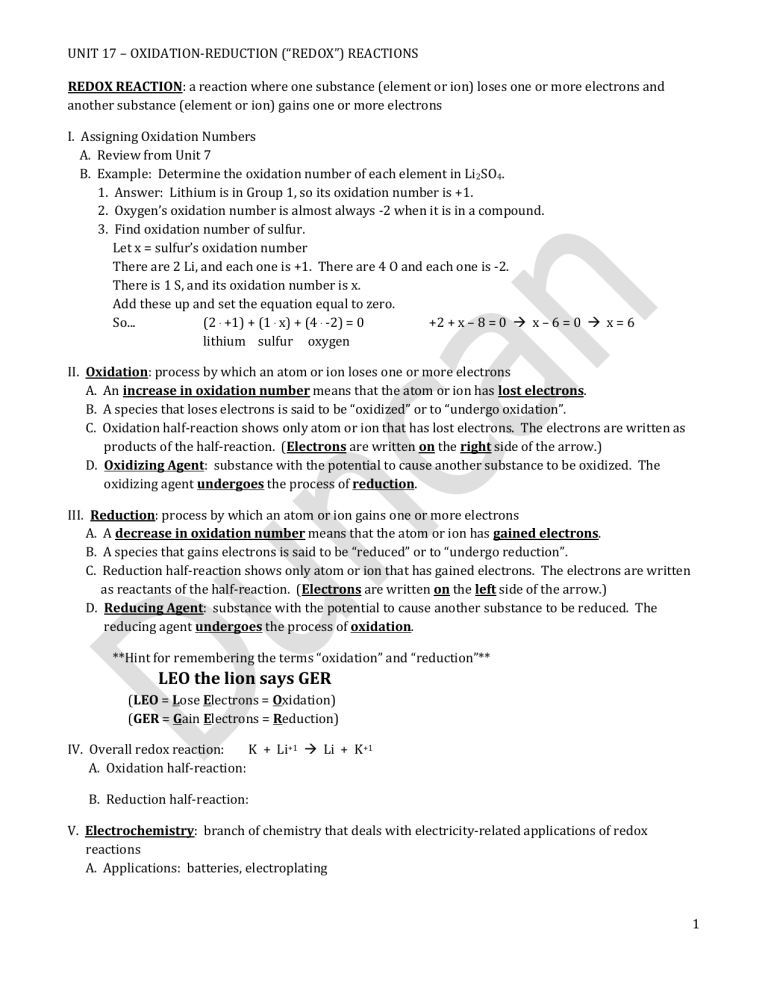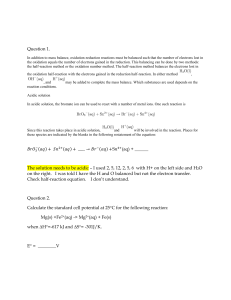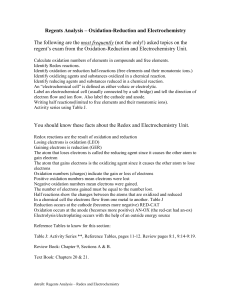LEO the lion says GER

UNIT 17 – OXIDATION-REDUCTION (“REDOX”) REACTIONS
REDOX REACTION : a reaction where one substance (element or ion) loses one or more electrons and another substance (element or ion) gains one or more electrons
I. Assigning Oxidation Numbers
A. Review from Unit 7
B. Example: Determine the oxidation number of each element in Li
2
SO
4
.
1. Answer: Lithium is in Group 1, so its oxidation number is +1.
2. Oxygen’s oxidation number is almost always -2 when it is in a compound.
3. Find oxidation number of sulfur.
Let x = sulfur’s oxidation number
There are 2 Li, and each one is +1. There are 4 O and each one is -2.
There is 1 S, and its oxidation number is x.
Add these up and set the equation equal to zero.
So... (2 .
+1) + (1 .
x) + (4 .
-2) = 0 +2 + x – 8 = 0 x – 6 = 0 x = 6 lithium sulfur oxygen
II. Oxidation : process by which an atom or ion loses one or more electrons
A. An increase in oxidation number means that the atom or ion has lost electrons .
B. A species that loses electrons is said to be “oxidized” or to “undergo oxidation”.
C. Oxidation half-reaction shows only atom or ion that has lost electrons. The electrons are written as
products of the half-reaction. ( Electrons are written on the right side of the arrow.)
D. Oxidizing Agent : substance with the potential to cause another substance to be oxidized. The
oxidizing agent undergoes the process of reduction .
III. Reduction : process by which an atom or ion gains one or more electrons
A. A decrease in oxidation number means that the atom or ion has gained electrons .
B. A species that gains electrons is said to be “reduced” or to “undergo reduction”.
C. Reduction half-reaction shows only atom or ion that has gained electrons. The electrons are written
as reactants of the half-reaction. ( Electrons are written on the left side of the arrow.)
D. Reducing Agent : substance with the potential to cause another substance to be reduced. The
reducing agent undergoes the process of oxidation .
**Hint for remembering the terms “oxidation” and “reduction”**
LEO the lion says GER
( LEO = L ose E lectrons = O xidation)
( GER = G ain E lectrons = R eduction)
IV. Overall redox reaction: K + Li +1 Li + K +1
A. Oxidation half-reaction:
B. Reduction half-reaction:
V. Electrochemistry : branch of chemistry that deals with electricity-related applications of redox
reactions
A. Applications: batteries, electroplating
1
UNIT 17 – OXIDATION-REDUCTION (“REDOX”) REACTIONS
B. Electrochemical cell
1. Anode : where oxidation takes place in an electrochemical cell
2. Cathode : where reduction takes place in an electrochemical cell
3. Electrons flow from the anode to the cathode !
OXIDATION
Losing electrons
Electrons written on right
Lower to higher oxidation # change
Reducing agent
Occurs at anode
REDOX REACTIONS WORKSHEET
REDUCTION
Gaining electrons
Electrons written on left
Higher to lower oxidation # change
Oxidizing agent
Occurs at cathode
Write the half-reactions for oxidation and reduction for these equations. Then, identify the oxidizing agent (OA) and the reducing agent (RA).
EXAMPLE: Mg + Br
2
MgBr
2
RA OA oxidation half-reaction: Mg 0
Mg +2 + 2 e - reduction half-reaction: 2 e- + Br
20
2 Br -1
1. Fe + Zn +2
Fe +2 + Zn
Oxidation half-reaction:
Reduction half-reaction:
Oxidizing agent:
2. 2 Al + 3 Fe +2
2 Al +3 + 3 Fe
Oxidation half-reaction:
Reducing agent:
Reduction half-reaction:
Oxidizing agent:
3. Zn +2 + Mg Mg +2 + Zn
Oxidation half-reaction:
Reduction half-reaction:
Oxidizing agent:
Reducing agent:
Reducing agent:
2







